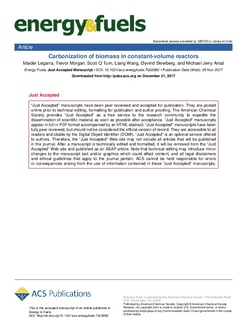| dc.description.abstract | A novel carbonization process that realizes near-theoretical fixed-carbon yields in ∼3 h is presented. Norwegian spruce and birch sawdusts were carbonized in a hermetically sealed reactor at an initial nitrogen pressure of 0.1 MPa. During a carbonization test, the reactor vessel retained all pyrolytic products inside the hot reaction zone invoking high pressures as the temperature was raised. Given the elevated partial pressures of volatiles and their extended residence times, secondary, heterogeneous, char-forming reactions between the hot solid and the tarry vapors appeared to be promoted. This resulted in charcoals with a remarkably high fixed-carbon yield, noncondensable gases mainly composed of CO2, and negligible amount of free tars. This work presents a reproducibility study on the experimental method and explores the effects of heat-treatment temperature, particle size, mass loading, and immersion time on product distributions and charcoal properties. Proximate and elemental analyses, heating values, and scanning electron microscopy images of charcoal are presented. Higher heat treatment temperatures (from 300 °C to 400 °C), smaller grains (from <2 mm to <0.2 mm), longer immersion times (from 30 min to 190 min), and greater mass loadings (from 130 g of biomass per liter of reactor to 165 g of biomass per liter of reactor) intensified wood devolatilization without losing charcoal fixed-carbon yields. Final charcoal products had lower volatile matter contents and improved fixed-carbon contents. Temperature produced the strongest effect, transforming the virgin spruce with a fixed-carbon content of 15% to charcoals with fixed carbon contents of 52% at 300 °C and 73% at 400 °C. The increase in temperature resulted in a transient plastic phase that changed the char appearance from loose, particulate matter to a smooth, shiny solid product with the appearance of coke. | nb_NO |

